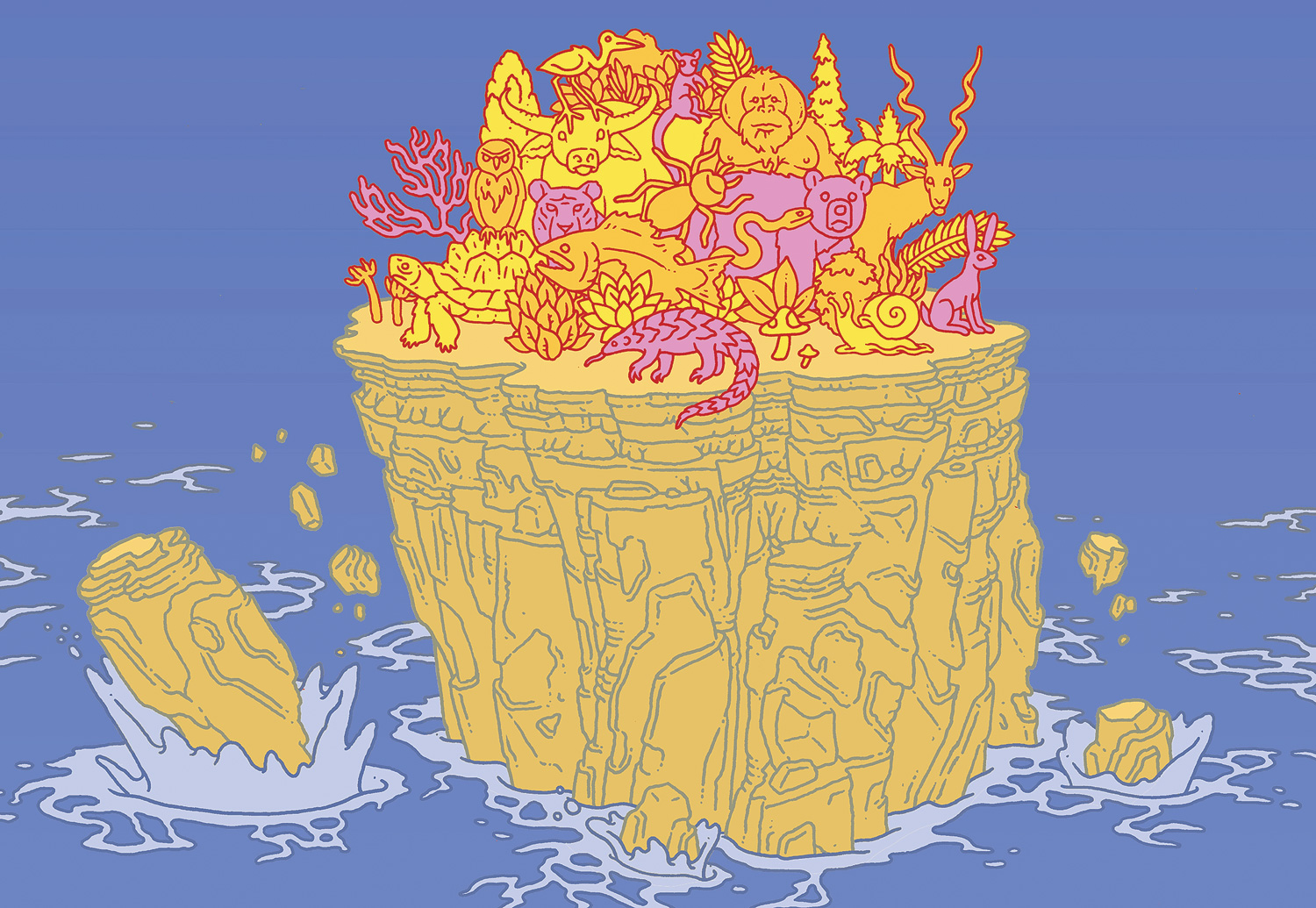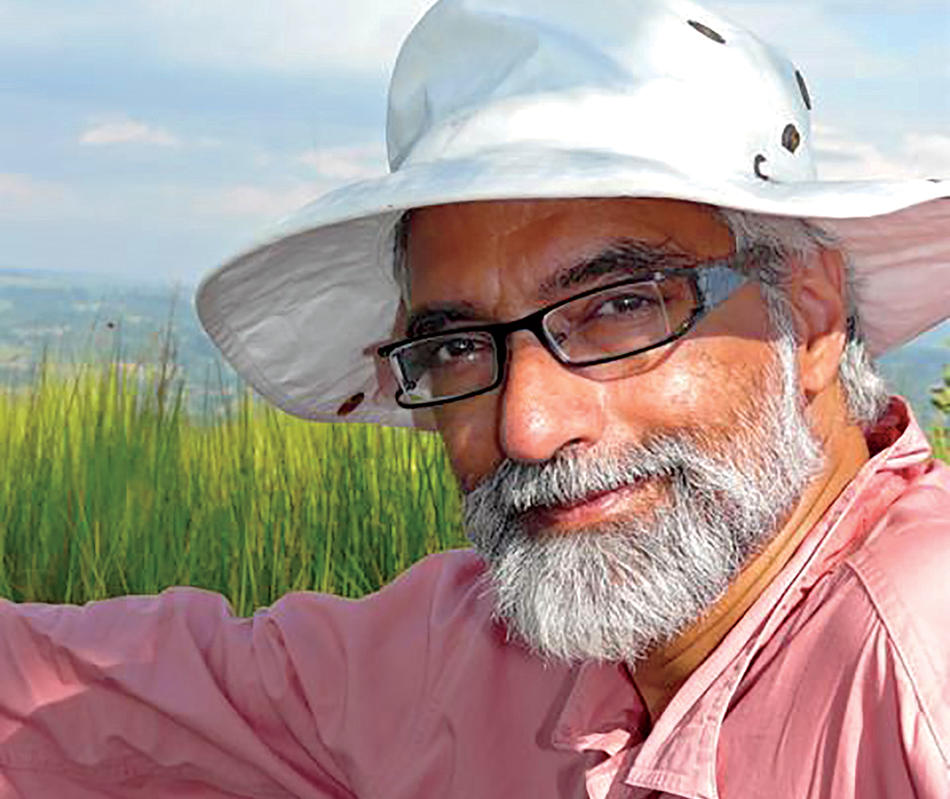
Shahid Naeem, the chair of Columbia’s Department of Ecology, Evolution, and Environmental Biology, is an expert on biodiversity. Columbia Magazine interviewed him about the world’s soaring extinction rates.
Can you tell us about your work?
I study the interconnectedness of plants, animals, and microbes. In particular, I look at what happens when you start to dismantle natural ecosystems by either removing native species or introducing invasive ones.
How serious is the problem of species extinction today?
We’re in the midst of a mass-extinction event unlike anything that’s happened since dinosaurs were mostly wiped out sixty-six million years ago. A report put together recently by the United Nations concludes that around one million species of plants and animals are now threatened with extinction, many within decades. We’ve already lost several million species over the past two or three hundred years, which means that we’re on course to reduce the earth’s total biodiversity by 75 percent or more.
We often hear about exotic creatures like tigers and pandas being endangered. But aren’t more-ordinary plants and animals threatened too?
Yes, thousands of species of amphibians, fish, coral, insects, microbes, mammals, and plants are at risk. And all these organisms are important, because collectively they make up healthy ecosystems that remove pollutants from our water and air, enrich our soil, nourish our crops, and regulate our climate systems. The ramifications of this ongoing and massive die-off could be profound.
When I teach, I like to use an old desktop computer as a prop to illustrate what we’re doing to nature: I take the back off, and while it’s running I’ll start snipping small wires with a pair of pliers. The students are shocked to see that the computer keeps working. But then I ask them how much they’d pay for it. They inevitably say, “Not much,” because common sense dictates that even if it is still running, it probably won’t be for long. And yet, I point out, we’re doing the same thing to the environment, and people don’t seem terribly concerned.
Of course, you can question whether nature is truly “designed” in the way a computer is. My argument is that nature does have a design to it, in the sense that it’s evolved over billions of years to function in a particular way.
So what will the earth be like if we continue on this course?
Dismal. If you lose 75 percent of all species — which is the scientific definition of a mass-extinction event — what emerges is an entirely different world. The climate is going to be different, the dominant life forms are going to different, and even the color of the sky could be different, since that blue hue is the result of sunlight being scattered by oxygen molecules and other particles produced by vegetation. Our planet has experienced a total of five previous mass-extinction events, and the fossil record shows the average recovery time is about ten million years.
Some people might say, “Well, we’ve already lost the dodo bird and the great auk and a few amphibian and butterfly species, and we seem to be doing fine.” But the scale and pace of the losses we’re experiencing are astounding.
What’s driving the current wave of extinctions?
Agriculture is a big player. In order to feed the world’s growing population, we’re converting vast stretches of forest, wetlands, and grasslands into farms and causing enormous amounts of chemical fertilizer to run off into rivers, lakes, and coasts. This is ruining the habitats of countless plants and animals, both on land and in water. We’re also overharvesting our oceans. On top of that, through international trade and travel we’re inadvertently introducing many species into new environments, which is wreaking havoc on local food chains. Black rats, for example, have managed to invade nearly every corner of the world. They’re threatening the survival of lots of birds and plants on tropical islands. We’re also unknowingly spreading infectious diseases among wildlife. A few years ago, people exploring caves in Europe apparently brought a bat disease called white-nose syndrome back to the US. The disease isn’t especially deadly to European bats, but it’s devastating bat populations in this country.
Are we suffering any serious consequences right now?
Yes, in so many ways. The loss of bats is a big problem for American farmers, because they’re an environmentally friendly form of pest control. With fewer bats to do the work, farmers are using more chemical pesticides. The collapse of honeybee populations is also causing headaches, requiring farmers to sometimes rent colonies of bees to pollinate crops. Shrinking populations of wild animals in US woodlands have even been linked to the Lyme-disease epidemic, since the forest floor is now dominated by tick-carrying rodents like white-footed mice.
Another concern is that by extinguishing so many plant species, we’re jeopardizing global food security over the long term. That’s because among the countless wild varieties of domestic crops, there are likely to be some that possess rare traits such as drought or heat resistance. By eliminating this reservoir of alternative crop varieties, we’re reducing our ability to adapt to global warming.
The authors of the UN report suggest that biodiversity loss is as severe a threat to humanity as climate change. Do you agree with that?
If I had to rank them, I would actually say that biodiversity loss is a scarier problem, because when species go extinct, there’s no bringing them back.
Climate change and biodiversity loss are closely intertwined, though. In fact, climate change is now considered a principal driver of biodiversity loss, in part because it’s altering the habitats of many species. And when humans destroy biodiverse rainforests, they also reduce the earth’s natural ability to remove carbon dioxide from the air. So a planet that’s less green and less biologically diverse is likely to be hotter and drier.
Climate change has certainly received more public attention than biodiversity loss. Why do you think that is?
Climate change is easier for people to get their heads around. They see its effects firsthand, with all the heat waves, droughts, forest fires, and floods we’re experiencing. The effects of biodiversity loss can be more difficult for people to recognize.
It’s important to note that the costs of biodiversity loss are more dramatic for people in the developing world, since they tend to be more reliant on natural resources in their immediate environments. For example, in many poor countries, local fish are a crucial source of cheap protein. So when marine ecosystems are disturbed — by either overfishing or pollution — people are in serious trouble. We’ve seen this happen off the coast of West Africa, where European fishing companies, having depleted the waters off their own coasts, have begun harvesting African waters. That’s exhausting the West Africans’ fishing stock and forcing many people to resort to eating bushmeat. And that, in turn, is contributing to the endangerment of monkeys, elephants, antelopes, and many other animals.
When you began your graduate studies, in the early 1980s, the term “biodiversity” hadn’t even been coined yet. How was the field of ecology different then?
Scientists who were interested in the diversity of life mainly saw it as a window into evolution. They wanted to know where individual species were situated on the tree of life and who was descended from whom. The questions that I and many other ecologists of my generation came to study — about how relationships among species affect ecosystems — didn’t really interest the previous generation of scientists. To the extent they even thought about the topic, they figured it didn’t much matter.
How could it not matter?
Well, imagine you’re standing in the middle of a dusty prairie. What would you think made it that way? You’d probably consider the annual precipitation, temperature, altitude, exposure to wind — climatic conditions dictated by large-scale geophysical forces. You might not guess the landscape could be significantly altered by something as simple as sprinkling some grass seeds, introducing a particular insect, or driving out a pack of predators. But study after study has shown that seemingly small ecological changes can have outsize consequences. There was a famous case a few years ago in which the reintroduction of a previously overhunted species of gray wolf in Yellowstone National Park changed the whole ecosystem, bringing populations of many other animals and plants back into balance and even stabilizing soil in a way that shifted the course of a river.
You published a landmark paper in 1994 that was the first to demonstrate how biodiversity influences the overall health of ecosystems.
To me, it always seemed intuitive that biodiversity is a powerful force in its own right. I got my chance to test the idea while working as a postdoctoral researcher at London’s Imperial College. There was a facility there called the Ecotron, consisting of growth chambers about the size of meat lockers in which you could control the light, temperature, rain, and just about every other climatic condition you could think of. They were essentially small biospheres. And what I did, as part of a team that also included the distinguished biologist Sir John Lawton, was to establish weedy little meadows in each chamber, with lots of plants, insects, worms, slugs, mites, and microbes. We put the same basic types of organisms in each chamber and held the climatic conditions constant; the only difference was that some chambers contained more species of each type than others. And what we found was that the more diverse ecosystems functioned better in most every respect: they produced more vegetation, they recycled organic matter faster, they retained more nutrients in their soil when it rained, and they even sucked more carbon dioxide out of the air.
That principle is now widely accepted.
Building on that work, ecologists have since developed formulas to assign monetary value to the individual components of ecosystems, determining the worth of honeybees in a patch of grassland, water-purifying vegetation on the banks of a reservoir, or deep-rooted trees holding mud in place on the side of a hill. This enables us to help farmers, water managers, forestry officials, and others anticipate the potential consequences and costs of altering local environments. Columbia faculty and students have worked on projects like these all over the world. A few years ago, I led a team with colleagues from the Department of Ecology, Evolution, and Environmental Biology that analyzed a tract of rainforest in Panama, quantifying how much more carbon dioxide the forest would draw out of the atmosphere if the country adopted timber-harvesting practices that preserved its rich diversity of tree species.
What kinds of solutions are needed to preserve biodiversity on a global scale?
I think improving education and research in this area is the most urgent need. Of the US government’s $150 billion annual budget for basic science research, only a tiny fraction — less than one-tenth of a percent — is spent on environmental-biology research projects. That’s not commensurate with the magnitude of the ecological problems we face.
Additionally, I think that agricultural systems need to be improved. In wealthy countries, the priority should be reducing the use of chemical fertilizers and pesticides. In developing countries, farmers need help increasing the amount of food they grow per acre, so that they can preserve more of their forests, grasslands, and wetlands. There’s a major movement now toward “sustainable intensification,” which combines organic-farming methods with some industrial-farming strategies, like the limited use of genetically modified crops and chemical fertilizers when they’re absolutely necessary. It’s a hybrid approach that has drawn criticism from some environmentalists, but I think that if we’re going to feed ten billion people by mid-century without destroying the planet, it’s the best chance we’ve got.
This article appears in the Fall 2019 print edition of Columbia Magazine with the title "Life on the Brink."



